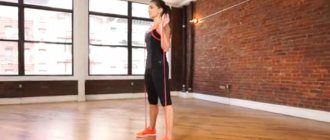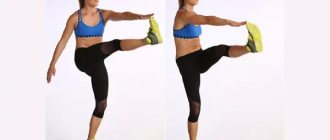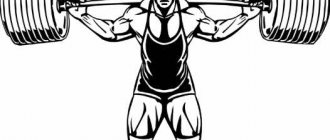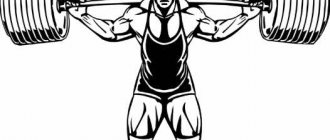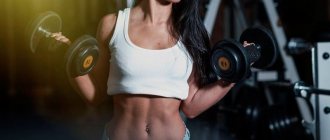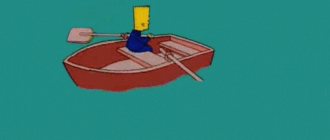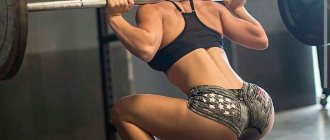The main goal that is set for every athlete involved in powerlifting is to lift the maximum weight in one of the basic exercises - bench press, squat, deadlift. Previously, this list consisted of four exercises. The large number of injuries that athletes received led to the exclusion of the standing barbell press from competitions. To lift weights in powerlifting, an athlete needs to develop strength.
Drawing up a training program for a powerlifter can only be done by an experienced athlete who fully understands the essence and ultimate goal of the entire process. Particular attention is paid to the individual abilities of the athlete, which include: strength, experience, anatomical and physical indicators. Beginners are recommended to start training on their own after visiting any powerlifting section. At the initial stage, you should find a mentor who can help with understanding the basics of powerlifting and the technique of performing basic exercises.
Performing powerlifting moves
The term “lift” refers to the maximum possible weight that an athlete can lift. It is a must for anyone who wants to practice this discipline. This is due to the peculiarity of the program, which consists in drawing up a training process based on a certain percentage of the weight lifted by the athlete. There are three types of training - light, medium, heavy. The first is to lift weights from 50, the second - from 65, and the third - from 90% of the weight that the athlete lifts.
In one day you can perform drilling on all muscle groups at once. The main thing is to take a long break between approaches. You can do a squat first, then a bench press, and then a deadlift. Of course, before each difficult approach you need to warm up and warm up well. It is best to work on the penetration with someone in pairs. This is necessary to correctly find the maximum liftable weight. The projectile in the final approach should be so heavy that it cannot be lifted. At the moment of failure, you will need the help of a partner who will back up the athlete. Otherwise, there is a risk of injury when pressing or squatting. The passage is carried out according to the principle from largest to smallest. At first, the step between approaches should vary from 10 to 20, and in the last attempts - from 2 to 3 kilograms.
What is powerlifting
Powerlifting is a strength sport, the essence of which is to develop the athlete’s strength, and the result is lifting the maximum possible weight. Thus, the achievements of a powerlifter are measured in the number of kilograms lifted.
Unlike regular bodybuilding, powerlifting does not involve the pursuit of beautiful body lines.
An athlete's qualifications are determined by performing basic multi-joint exercises. Performance is assessed according to three parameters:
- correct execution technique;
- total weight taken;
- number of repetitions.
All three factors are taken into account in competitions. Moreover, with the same weight taken by two athletes, victory will go to the one whose body weight is less.
Powerlifting training
The training program is developed by an experienced specialist who takes into account the results obtained during the excavation and individual capabilities. The total duration of each training plan is a maximum of three months. This limitation is due to the body getting used to it and the lack of any progress. After 90 days, you need to perform the excavation again and change the program.
Most of the training developed to increase strength in powerlifting involves training three times a week. The training process is designed in such a way that between the day of performing squats and deadlifts, there is always a bench press session in the schedule. This step is explained by the high load on the legs when performing deadlifts and squats. Therefore, this muscle group needs more time to recover, which is what makes a bench press day possible. When two basic exercises are performed at once in one workout, then one is performed with light weight, and the other with heavy weight.
All of these principles together make up a powerlifting training program.
Basic Training Principles for Strength Development
Powerlifting training is exclusively strength-based. Which means a periodic but regular increase in the intensity of training and an increase in the volume of the total load produced in the form of weights lifted by the athlete.
In practice, the training regimen looks like this: Powerlifters work on one or two multi-joint competition movements each workout, in 4-6 sets, with a low number of repetitions (2-5 repetitions).
This is another difference from bodybuilding, in which athletes most often work out only one or two muscle groups in one workout, performing 3-4 working approaches for an average number of repetitions (8-15).
No. 1 Training program
First day:
- Heavy Press
- Light squats
- If you still have some strength left, you can do a French press or dips.
Second day:
- Deadlift
- If there is strength left, then we do hyperextensions and biceps curls + hammers.
The third day:
- Light press
- Squats are heavy
- If there is strength left, then we work on the deltas - swings in an incline, to the sides, in front of us.
Training weights will depend on the results of your progress, that is, on the maximum performance. The number of repetitions and method of execution will depend on the cycle you use (the Russian and Verkhoshansky cycles are very famous in powerlifting). Professionals know how to use these cycles, but for beginners, we recommend contacting a trainer who will guide you in the right direction.
Choosing a trainer and gym
Where should a newbie start? From choosing a gym. There, a novice lifter will find a good trainer who will point out mistakes and teach the correct technique for performing exercises. He will help you create a training plan and rest schedule.
Proper technique is important to a beginner's progress. Doing exercises incorrectly will only harm your health. If at first it is not possible to find a trainer, and you don’t want to put off training, then you can resort to video recording of your classes. Later, during rest, you can review them and identify errors in the technique. The video lesson at the end of the article has enough information about exercises for beginner lifters.
There is a unique publication in print: Sheiko’s book – “Powerlifting the path from beginner to master.” This book is a synthesis of the instructions of honored coaches and masters of sports of the Soviet Union for both beginning athletes and advanced lifters.
No. 2 Training program
Day 1 – chest:
- Light squats - 5 sets of 5 reps with 60% of the maximum weight;
- Bench press – 5×5 with 70-100%;
- Military press – 5×10.
Day 2 – back:
- Deadlift – 5×5 with 70-100%;
- Shrugs – 5×20;
- Close-grip triceps press – 5X10.
Day 3 – legs:
- Squat – 5×5 with 70-100%;
- Calf raises – 4×20;
- Barbell row to the chin – 4×10.
The duration of this training cycle should not exceed 3 months. Train 3 times a week, in the first 7 days work with 75% of your maximum, which you set on the tunnel. Next week work with 80%, and then increase the working weight by 2.5% each week. After the end of the program, it needs to be replaced, or started over again, doing the penetration again.
Powerlifting Exercises
Exercises in powerlifting do not differ in variety. The most important thing is a gradual increase in weight and very clear and competent adherence to technique. The technique must be honed to perfection, because the work is carried out with a lot of weight, and violations in the execution of exercises can lead to serious injuries.
Squats with a barbell on your shoulders, how to do it correctly
This exercise is a basic exercise for lifters. It engages the muscles of the entire body, but mostly the legs, buttocks, core and abs.
Technique:
- Grasp the bar with both hands, bring your shoulder blades together, place the bar on your middle trapezius and rear deltoids. Stand under the barbell, distributing your weight evenly on both legs. Remove the barbell from the bar and take two steps back with your feet approximately shoulder-width apart or slightly wider. This will be the starting position.
- As you inhale, bending your knees, we squat. We keep the back straight, without bending, only the natural lordosis in the lower back remains. We direct our gaze straight ahead. We concentrate on the tension in the leg muscles. The body leans forward slightly, the knees do not go beyond the line of the toes. The legs stand firmly on the entire foot.
- At the exit, we straighten our legs and stand in the starting position.
- Repeat the required number of times.
Basic exercises for lifters
A variation of the exercise is the front squat. The technique is the same, only we place the barbell on the upper part of the chest and deltas. In this case, the emphasis is on working the quadriceps.
Video: Squats with a barbell on the shoulders - strength training
Close grip bench press
The exercise targets the shoulders, forearms and trapezius.
A
Technique:
- We lie down on the bench, grab the barbell with an overhand grip, placing our hands slightly narrower than our shoulders (at a distance of about 20–30 centimeters from each other).
- We remove the barbell from the bar and smoothly lower it to the chest.
- Slowly raise the barbell up as you exhale, fully straightening your arms.
- As you inhale, lower the barbell to your chest again.
- Repeat as many times as necessary.
Bent-overs with a barbell on your shoulders
This exercise perfectly works the back muscles, gluteus maximus, spinal extensor muscles, and abdominal muscles.
V
Technique:
- We stand straight, legs slightly wider than shoulders, slightly bent to the knees, toes slightly turned away from each other.
- We take a barbell and place it on the upper trapezius and rear deltoids.
- As you inhale, moving your pelvis back, bend down with the barbell. Movement occurs only in the hip joints. Ideally, you should bend over at a 90-degree angle until your torso is parallel to the floor.
- We return to the starting position as we exhale.
- Repeat as many times as necessary.
This exercise can be quite traumatic; beginners are advised to exclude it or perform it with an empty bar.
Video: Forward Bends with a Barbell on the Shoulders
Deadlift
A classic exercise for bodybuilding and powerlifting. It is a basic exercise and works muscles such as:
- spinal extensors;
- latissimus dorsi muscles;
- upper back muscles;
- buttocks;
- thigh muscles;
- quadriceps;
- muscles of the forearms.
Exercise to work the muscles of the back, legs and forearms
Technique:
- Starting position: feet shoulder-width apart, parallel to each other, toes on the bar of the barbell lying on the floor. We grab the bar with an overhand grip, with our wrists slightly wider than shoulder-width apart, our arms perpendicular to the floor, and our shoulders positioned directly above the bar.
- As you exhale, we lift the barbell smoothly and evenly, the bar sliding along the legs. Raising the barbell above the knees, straighten the torso as much as possible and bring the shoulder blades together, concentrating on working the back muscles.
- Moving the pelvis back, we gradually lower ourselves to the starting position, also sliding the bar along the legs.
- Once the pancakes touch the floor, repeat the required number of times.
During the exercise, the lower back should be slightly arched at all times, and the gaze should be directed upward. There is no need to make sudden jerks; we work extremely smoothly and calmly.
Video: Deadlift
Hyperextension
This exercise works great on the back muscles and the back of the thighs. It is performed in a special simulator.
Back exercise
Technique:
- We customize the simulator to suit your height. It is important that your feet rest comfortably on the bolsters. We take the starting position: straightened up in the simulator, hands behind the head.
- We lower the body down at a right angle to the legs while inhaling. The back remains straight.
- As you exhale, raise your body to the starting position, tensing the muscles of your legs and buttocks.
- Repeat as many times as necessary.
Video: Hyperextension technique
Straight-legged barbell row
An exercise that trains the gluteal muscles and hamstrings, as well as the back extensors and lower back.
Differs from the classic deadlift in that the legs remain straight.
Technique:
- Starting position: stand straight, grab the bar with a straight grip, palms shoulder-width apart.
- Keeping your back straight, bend forward as low as possible while inhaling. If it turns out with a straight back until the body is parallel to the floor, it’s good; if the back begins to round, we linger in an accessible position.
- As you inhale, we return to the starting position.
- We repeat the required number of times.
No. 3 Training program
Day 1:
- Heavy squat - 5x5 - 75-85%;
- Light bench press – 5×5 – 65-70%.
Day 2:
- Deadlift – 3×5 – 75-80%;
- Bent-over barbell row – 3×6-8.
Day 3
:
- Light squat 3×5 – 55-70%;
- Press heavy 5×5 – 75-85%;
- Close grip press 3x8-10.
Classes 3 times a week. The use of this powerlifting training program is recommended for beginner athletes. If you have the desire and strength, then you can add a couple of isolated exercises for individual muscle groups to the basic exercises, but practice shows that this set is enough for a beginner.
Base - the basis of training
Powerlifting (eng. powerlifting, power - “strength”, lifting - “lifting”) is a sport in which an athlete overcomes the weight of his maximum weight. Powerlifting, or otherwise powerlifting, consists of three main disciplines:
- squats;
- bench press on a horizontal bench;
- deadlift.
This golden trinity is called classic basic exercises. They involve several muscle groups and joints at once. They are the basis for building muscle mass and strength for a beginner.
Nutrition for a lifter
A new lifter needs to plan his diet. It should consist of healthy products. A balanced diet includes proteins, fats and carbohydrates.
What to choose in food:
- meat and fish;
- cereals (rice, buckwheat, oatmeal, pearl barley, etc...);
- pasta;
- eggs;
- dairy products (milk, cottage cheese, kefir);
- vegetables and fruits.
Food should be taken 5-6 times a day, in small portions. After training, it is useful to drink a gainer with amino acids. And after an hour, eat a hearty meal and regain strength.
Rest after training should be complete, stress-free. Sleep duration is at least 8 hours. The athlete’s recovery and progress depend on this.
